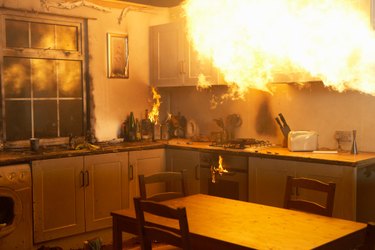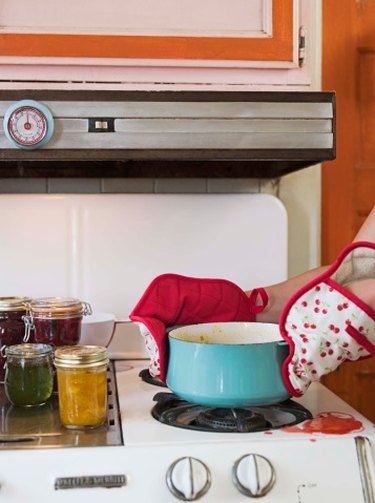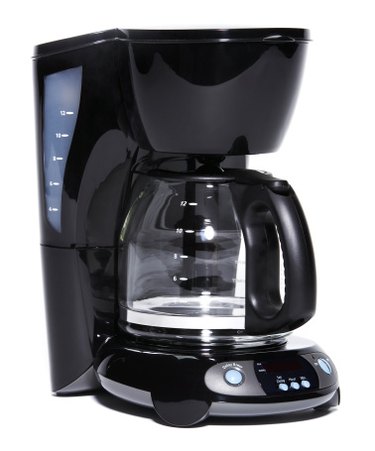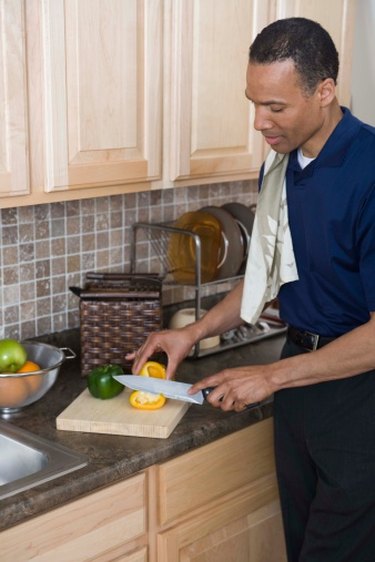
Anyone who spends time in a kitchen should learn the safety rules that apply to the equipment he or she will be using. Cuts and burns can be avoided by learning how to use tools and appliances properly and safely. Keep yourself safe in the kitchen by being aware of safety precautions and practicing them every time you cook.
Stoves
Video of the Day

Care must be taken when using a stove because of the intense heat it can produce, both on the cooktop and inside the oven. Match pots and pans to the size of the burner and turn handles away from you while in use.
Video of the Day
When frying foods, use only as much oil as you need to completely submerge the item being fried, and leave plenty of room for the food that is being cooked so that the displacement caused by adding food doesn't cause the oil to spill over the top of the pot. Be very careful when adding frozen foods to hot oil--their ice crystals can cause a violent bubbling in hot oil, and could result in oil spilling under the burner, potentially causing a grease fire.
Vent smoke and cooking steam through the range hood, and be sure to remove its filter and wash it regularly to reduce grease build-up, which can catch fire.
Do not use a wet pot holder or dish cloth to remove items from the oven--these conduct heat instantaneously and can cause severe steam burns. Watch broiling foods carefully to ensure they do not burn or burst into flame from their proximity to the intense heat source. Clean up spills in the oven as soon as it is cool. Remove foods from the oven carefully to avoid spilling hot food.
Small Appliances

Small appliances such as microwaves, food processors, blenders, toasters, toaster ovens and coffee pots should have short cords. Always plug these appliances in near an outlet rather than connecting them to an extension cord. Observe all manufacturer warnings.
Be sure to unplug a coffee pot when you are finished consuming it for the day--coffee left over a burner turns into a very thick residue in the bottom of the carafe. Never reuse a carafe after this has happened--the carafe could shatter next time the pot is full, causing burns or cuts.
Check to ensure any plates or containers you place in the microwave are microwave-safe. When heating liquids in the microwave, retrieve them very carefully and stir them with a long-handled utensil to be sure no bubbling over will occur. Poke holes in potatoes before microwaving them to allow steam to escape; failing to do this can result in an exploded potato and a nasty burn.
Knives

Sharp knives are actually less dangerous than dull ones, because a sharp knife will glide through the meat or vegetable you are chopping, but you will be tempted to force a dull knife to accomplish the same task--keep knives honed.
Match the knife to the chore: use a paring knife for peeling skins from fruits and vegetables, a small chef's knife for dicing and chopping, and a bread knife for sawing slices of bread. Never hold a knife by the blade and always hand a knife to others by turning the handle toward them.
Do not place knives in a sink full of soapy water where they cannot be seen. Use a knife caddy or block to store sharp knives; allowing them to lie loose in a drawer can cause cuts when you thrust your hand into it.
Cutting Boards and Other Kitchen Surfaces

Maintain two separate cutting boards: one for meats and the other for fruits and vegetables. Meat juices can contain bacteria that may contaminate other foods if you cut up meat on the same board where you prepare salads. Meat juices can also be absorbed into wood cutting boards--consider using plastic cutting boards for meats and disinfect them with a tablespoon of bleach in a gallon of water periodically or run them through the dishwasher.
Disinfect countertops and sinks regularly, especially after raw meats have come in contact with them. Be sure to wipe up spills of meat juices in the refrigerator to avoid contamination of other foods as well.